Establishing a Home Fruit Orchard
In years past, most every home had fruit trees growing in the yard or a small orchard. Over time, these fruit trees were replaced with oaks, maples, crape myrtles, and other ornamental shade trees. Now, many homeowners are looking to grow their own fruits again. There are many things to consider about establishing a home fruit orchard before getting started. The information provided here will help to guide you in the process.
Site Selection
Fruit plants do best in full sun, and they need adequately drained soil and a nearby water source. Full sun is a minimum of 8 hours of direct sunlight, with more being better. Fruit plants should be planted away from large trees that can shade them and compete with their roots for water. Soils that drain well are a must for any fruiting plant, as they cannot survive in areas where roots stay wet. Internal drainage should be a minimum of 2 inches per hour. An area with a slight slope or rolling hills is considered better than flat land (Figure 1). Fruit plants need to be watered regularly throughout their life span, and especially at establishment, so having them close to a water source is a must. Plants need additional water when they are fruiting in order to produce healthy, quality fruit.

Soil Sample
Take a soil sample during the planning phase to gauge the nutrient levels and pH of the soil. This will tell you the correct amount and type of fertilizer to apply and the proper application timing. The soil pH report may indicate if an area is not a suitable location for the desired crops, as not all crops can grow in all soils. This report will also give instructions for applying lime to raise the pH or sulfur to lower the pH, if needed. You can get soil test kits and forms at any county Extension office. It may take a few weeks to get the results of your soil test back, so allow for that time. See the Extension for Real Life video How to Take a Soil Sample.
Site Preparation
Numerous steps will be involved in preparing the orchard area. First, remove all weeds and grasses from the rows where the plants will be placed. This may involve spraying herbicides, tilling, disking, plowing, or a combination of these. It may take multiple applications to get the rows clean and free of weeds. Second, till or disc the plant rows to loosen the soil and prepare the planting area. Some crops, such as blueberries, strawberries, and peaches can benefit from having the soil raised up into a bedded row or berm to improve drainage. Third, amend the soil to either hold more water or to improve drainage, depending on your situation. To hold more water in the soil, compost or organic matter is the preferred amendment. To improve drainage, use pine bark mulch or another large-particle amendment. Fourth, add lime or sulfur as recommended by the soil test report and disk it in (Figure 2).
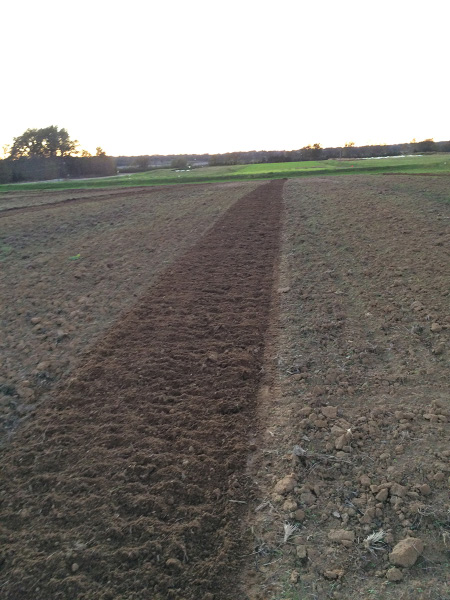
Plant Selection
Select the type of plant and cultivar of each that you want to grow. See MSU Extension Publication 966 Fruit and Nut Recommendations for Mississippi for more info. The most important factor is to select plants that are suited to grow in your location or cold-hardiness zone. Mississippi cold-hardiness zones range from 7b in north Mississippi to 9a on the coast (Figure 3). It is also important to know the number of chill hours your location receives. Mississippi ranges from 300 to 1,100 average chill hours, where 1 chill hour is equal to 1 hour below 45°F. Selecting a cultivar that requires more chill hours than your area provides may cause it not to produce fruit, while a cultivar that requires too few chill hours may bloom too early, resulting in freeze-damaged flowers. See Extension Publication 3067 Chilling-Hour Requirements of Fruit Crops for more info. It is also important to select cultivars with known resistance to diseases that occur in your area. The fruit tree provider/nursery can offer advice on specific cultivars.

Purchasing Plants
Homeowners can buy fruit plants that are grown bare-root or in plastic containers. Container-grown is typically the preferred method since the roots have not been cut and are completely intact (Figure 4). Also, these plants are available for a longer period at local nurseries, allowing a longer planting window. Bare-root plants also work, as long as the roots have not dried out before planting (Figure 5). Fall/winter planting is preferred over spring planting when possible; plants will need less water initially and roots will begin to form during the winter months, allowing for greater survival rates during the first summer period. If ordering plants from a nursery, remember to order early—in some cases up to 1 year in advance—to ensure a good choice of varieties.
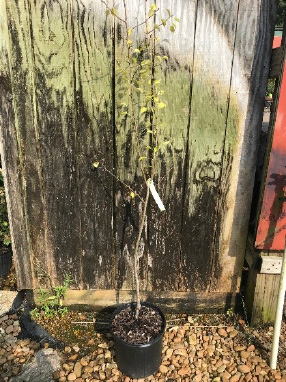
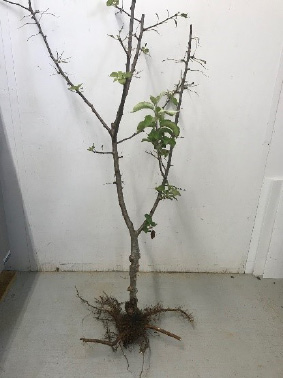
Trellis Installation
If you are using a trellis, it is easier to install before planting. Trellis systems work well for muscadine, grape, and blackberry plants, as well as some tree varieties. There are numerous trellis methods, such as one line above another, one or two wires at the top of the trellis (like a clothes line), or even a v-system (Figure 6). Set the end and center posts in concrete to provide stability. Then, install wires through or attach them onto the posts. Plants or vines can then be trained onto the trellis system. You can find one design in Extension Publication 2290 Establishment and Production of Muscadine Grapes. Others are available online.
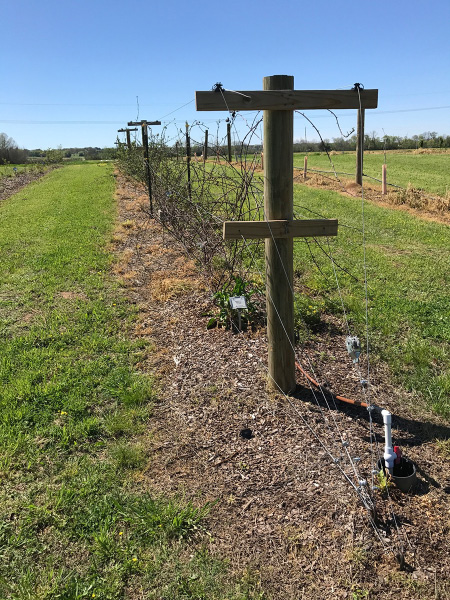
Irrigation Installation
Fruit plants need adequate and consistent water to produce a quality crop. Numerous methods and systems can be used, but the key is to have enough water capacity and full coverage. You need to determine the number of plants to water, amount of pipe needed, number of emitters, and gallons per minute (gpm) capacity of the system. There are softer lines that last only 1–2 years or more durable lines that can last 5–7 years (Figure 7). To help avoid costly mistakes, an irrigation professional should calculate the system components you need.

Orchard Design
Group similar fruits together to make maintenance tasks easier. For example, apples and pears are fertilized and treated for insects/diseases at similar times and with similar products. The same is true for peaches, nectarines, and plums. Planting these groups of plants together will make treatment options more efficient. Proper design can also improve flower pollination. For example, having two rows of apples with five trees in each row (Figure 8) should provide better pollination than a single row with 10 apple trees. This is usually referred to as block planting. Spacing in the rows and between the rows is based on the fruit type being grown. Proper spacing helps with plant health and general maintenance tasks such as mowing, weeding, and spraying. Table 1 gives recommended spacing guidelines.
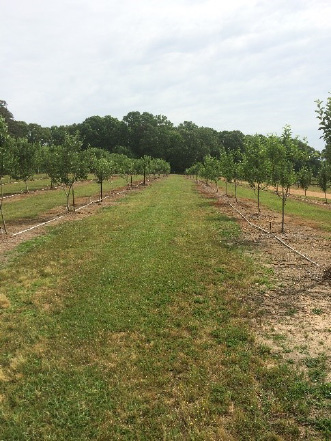
|
Fruit crop |
Space in the row (ft) |
Space between rows (ft) |
|---|---|---|
|
apple/pear |
15–20 |
20 |
|
peach/plum |
16–20 |
20 |
|
Japanese persimmon |
16–20 |
20 |
|
pecan |
30–40 |
30–40 |
|
blueberry |
4–6 |
10 |
|
blackberry |
2–3 |
10 |
|
muscadine |
15–20 |
12 |
|
bunch grape |
6–8 |
12 |
Plant Installation
If plant rows have been properly prepared, installation is easy. Dig the hole with a shovel and place the plant root ball level with the soil line or slightly above (Figure 9). Next, backfill with amended soil and tamp the soil to remove air pockets. Then, water thoroughly and backfill with additional soil if needed. Lastly, apply mulch around each plant or down each row. This will keep weeds to a minimum, retain soil moisture, control soil temperature fluctuations, and keep mowing/weeding equipment away from the tree trunk. Apply up to 3 inches of mulch over the root area and taper down to ½ inch where the soil meets the trunk (Figure 10).
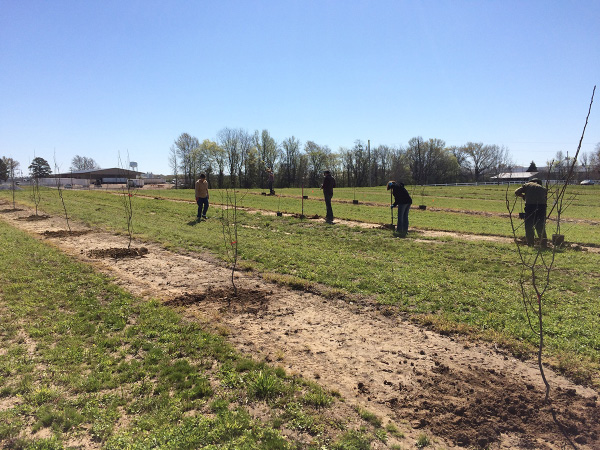
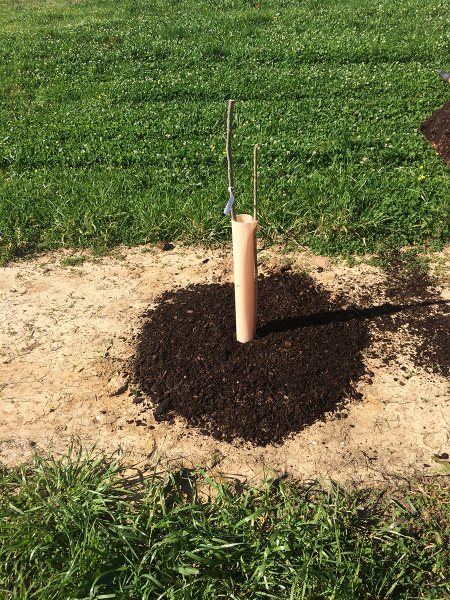
Labeling
Each plant within the orchard needs to be labeled with a permanent, metal tag. Plastic tags fade and are easily torn from the plant. Tag each plant immediately after it is installed.
Summary
Before planting a home orchard, you should consider all of the factors discussed in this publication. Growing fruits in Mississippi can be a real challenge, especially if the plants aren’t carefully selected and properly installed. Following the steps outlined here will increase plant survival and your chances of harvesting healthy fruits. There are numerous MSU Extension publications outlining specific fruit crop recommendations for Mississippi. These are available from your local Extension office or online.
Publication 3410 (POD-12-19)
By Jeff Wilson, PhD, Assistant Professor, Casey Barickman, PhD, Assistant Research Professor, and Susan Worthey, Research Associate, North Mississippi Research & Extension Center.
Copyright 2019 by Mississippi State University. All rights reserved. This publication may be copied and distributed without alteration for nonprofit educational purposes provided that credit is given to the Mississippi State University Extension Service.
Produced by Agricultural Communications.
Mississippi State University is an equal opportunity institution. Discrimination in university employment, programs, or activities based on race, color, ethnicity, sex, pregnancy, religion, national origin, disability, age, sexual orientation, genetic information, status as a U.S. veteran, or any other status protected by applicable law is prohibited. Questions about equal opportunity programs or compliance should be directed to the Office of Compliance and Integrity, 56 Morgan Avenue, P.O. 6044, Mississippi State, MS 39762, (662) 325-5839.
Extension Service of Mississippi State University, cooperating with U.S. Department of Agriculture. Published in furtherance of Acts of Congress, May 8 and June 30, 1914. GARY B. JACKSON, Director
The Mississippi State University Extension Service is working to ensure all web content is accessible to all users. If you need assistance accessing any of our content, please email the webteam or call 662-325-2262.








